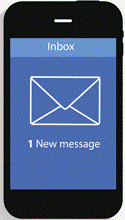
By Kristen Cifolelli, courtesy of SBAM Approved Partner ASE
According to Adobe’s 2017 Consumer Email Survey, the average employee spends 3.3 hours per day checking and responding to their emails. If you do the math, that equals 16.5 hours a week, which is 41% of a standard 40-hour work week. The average amount of emails a typical employee receives is 122 per day. A study by the Danwood Group found that it takes an average of 64 seconds to recover from an email interruption (regardless of the email’s importance) and return to work at the same work rate as before the interruption. For someone receiving 100 emails a day, approximately 1.7 hours a day is lost in email interruption recovery time alone. So, what do all these statistics mean?
Email interruptions comprise a significant portion of an employee’s daily interruptions. People increasingly expect their correspondents to answer emails within hours, if not minutes – putting pressure on everyone to constantly monitor their inboxes. For many employees this can create email burnout, leaving them feeling stressed, overwhelmed, and emotionally exhausted from the pressure of keeping up with email. In an effort to prevent email burnout, some employers have started to suggest, or even mandate, ways in which employees should unplug their connected devices.
In late March, the New York City Council via a campaign entitled “Time Out New York” recently proposed a restriction on employers requiring employees to respond to emails outside of their regular working hours. The legislation would apply to employers with 10 or more employees and would require the following:
- Define normal work hours for each class of employee
- Have a written policy regarding communication during non-working and holiday hours
- Inform employees of the right to file a complaint related to this policy
While the chance of this legislation becoming law in New York City is slim, other employers and even the country of France already passed this type of law or created similar polices. In January 2017, French law established the “right to disconnect” for workers. The law requires companies with more than 50 employees to establish hours when staff should not send or answer emails. The goals of the law includes making sure employees are fairly paid for work and preventing burnout by protecting private time.
In 2011 Volkswagen took steps to limit after-hours emails to reduce burnout among workers. In 2014, Daimler introduced a mail-blocking policy for staff who go on holiday. Anyone who sends an email to someone who is away, will receive a message that their email was not received, and an alternate contact will be provided. Should your organization have an after-hours email ban?
Banning after hours email is not going to be a practical policy for most employers. This will be especially true for organizations that are global. While creating hard and fast rules regarding when employees can connect and send emails may have the intent to help create better work-life balance, it may actually end up hindering many workers who need the flexibility of working after hours. Ultimately, there is most likely no one-size-fits-all email strategy that will work for all employees as everyone works differently. Instead, here are some steps employers can take to help employees manage email stress:
- Create realistic email response guidelines – while certain roles (especially ones that are client facing), require email response time requirements, setting blanket email response requirements across the board, can create an unnecessary pressure that cause high levels of strain for workers that may not be necessary. This can promote a reactive rather than strategic approach. In many cases, many email senders do not expect or require a quick response. Employers should set realistic expectations regarding email response time, and don’t set ones that may be counterproductive.
- Lead by example – if an employer is promoting work-life balance as something that is important, then don’t model the opposite behavior. For example, don’t create a culture where managers are sending emails at all hours of the night. Instead encourage both managers and employees to create digital boundaries outside work hours. One such strategy is to encourage managers and employees to use the delay send feature on email. This will show subordinates that work-life boundaries are respected.
- Create a culture where employees don’t feel guilty for setting time to focus on projects or down time out of work – where possible, allow employees to set specific times to check email, and only check during such times. If there is a concern about responsiveness, intermediate times can be set up whereby subject lines of emails can be scanned, and only emails that appear to be emergencies will be opened.
- Turn off email alerts – encourage employees to turn off new email alerts. It has been shown that the instant notification of a new email alert doesn’t help anyone to feel more on top of things. Instead, it creates pressure to check new messages. This constant multi-tasking actually reduces productivity.
- Teach managers to recognize burnout – managers should learn to recognize signs of burnout and be prepared to offer solutions. Employers should create a culture that encourages open communication whereby employees feel comfortable raising concerns about their workload, pressures they are feeling, and asking for clarification of expectations if required.
Ultimately the amount of email and different types of electronic communication is only expected to increase over the coming years. Employers should encourage employees to find ways to take control of email rather than allow email interruptions to increase the pace of work, extend the workday, and cause stress. Employers should consider offering training in the appropriate use of email and to create a culture that offers employees the ability to have down time outside of work.